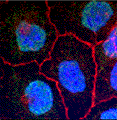Biochemistry, Department of
Document Type
Article
Date of this Version
2012
Citation
Sandai D, et al. 2012. The evolutionary rewiring of ubiquitination targets has reprogrammed the regulation of carbon assimilation in the pathogenic yeast Candida albicans. mBio 3(6):e00495-12.
Abstract
Microbes must assimilate carbon to grow and colonize their niches. Transcript profiling has suggested that Candida albicans, a major pathogen of humans, regulates its carbon assimilation in an analogous fashion to the model yeast Saccharomyces cerevisiae, repressing metabolic pathways required for the use of alterative nonpreferred carbon sources when sugars are available. However, we show that there is significant dislocation between the proteome and transcriptome in C. albicans. Glucose triggers the degradation of the ICL1 and PCK1 transcripts in C. albicans, yet isocitrate lyase (Icl1) and phosphoenolpyruvate carboxykinase (Pck1) are stable and are retained. Indeed, numerous enzymes required for the assimilation of carboxylic and fatty acids are not degraded in response to glucose. However, when expressed in C. albicans, S. cerevisiae Icl1 (ScIcl1) is subjected to glucose-accelerated degradation, indicating that like S. cerevisiae, this pathogen has the molecular apparatus required to execute ubiquitin-dependent catabolite inactivation. C. albicans Icl1 (CaIcl1) lacks analogous ubiquitination sites and is stable under these conditions, but the addition of a ubiquitination site programs glucose-accelerated degradation of CaIcl1. Also, catabolite inactivation is slowed in C. albicans ubi4 cells. Ubiquitination sites are present in gluconeogenic and glyoxylate cycle enzymes from S. cerevisiae but absent from their C. albicans homologues. We conclude that evolutionary rewiring of ubiquitination targets has meant that following glucose exposure, C. albicans retains key metabolic functions, allowing it to continue to assimilate alternative carbon sources. This metabolic flexibility may be critical during infection, facilitating the rapid colonization of dynamic host niches containing complex arrays of nutrients.
Included in
Biochemistry Commons, Biotechnology Commons, Other Biochemistry, Biophysics, and Structural Biology Commons



Comments
© 2012 Sandai et al. This is an open-access article distributed under the terms of the Creative Commons Attribution-Noncommercial-Share Alike 3.0 Unported License